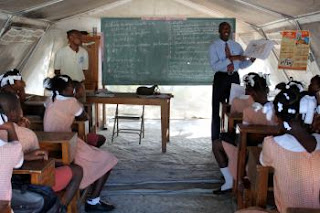The crushed and broken buildings in Port au Prince saddened me, as did the makeshift homes, usually tents, in any vacant space from a rooftop to an alleyway.
 |
| Amidst the breathtakingly beautiful landscapes, thousands apon thousands of rickety shelters have been put up in any available free space. Photo: Hilary Atkins |
The rotting garbage and chaotic traffic, (a sure sign of poor leadership) depressed me as much as the ugliness created in an already disfigured city by thousands of election posters advertising the very people who should be cleaning up.
And I was burdened by the inevitable guilt that goes with being a foreigner in a car, when most of the population have nothing except the ability to survive.
Yet I was surprised by the beauty of the rolling green landscape, which is always around you - the result I suppose of ancient seismic movements like the one experienced in January – which no politician can destroy.
And I was inspired by the resilient, smiling people, rising at 3 or 4 in the morning to be at work by 7, clean and smartly dressed. I also admired their courage in the face of extra adversity such as the cholera outbreak and the hurricane.
I was fascinated by the streets of Port au Prince, where, as in any overcrowded and under-resourced city, all business takes place. Small vignettes stick in my mind: the man carrying a heavy TV set on his head; the lady examining a second-hand bed sheet; the little girl begging, bemused when a passing lady dropped a US dollar in her hand; and the tap-tap (brightly coloured taxi) that said, Merci Jesus, despite all the hardship.
 |
| Sometimes, the Haitian's resilience in the face of poverty, civil unrest, famines, natural disasters, and most recently disease, defies comprehension. Photo: Hilary Atkins |
Most of all I was absorbed, entertained and engaged by the children in the school and the village, who surrounded us as we worked. The noise from the classrooms was incessant, a mixture of chatter, singing and learning by rote, impossible to escape, but a constant reminder of why we are here – to help each child, as one co-worker put it, “become a better person for tomorrow”.
 |
| The bursting classrooms make for plenty of noise... Photo: Hilary Atkins |
And now I hand over to Sophie who will be a more permanent feature of the children’s village because she is staying much longer. With 13 months of living in children’s villages in Latin America, she already feels at home. Welcome, Sophie, to the SOS Children’s Village Santo.




